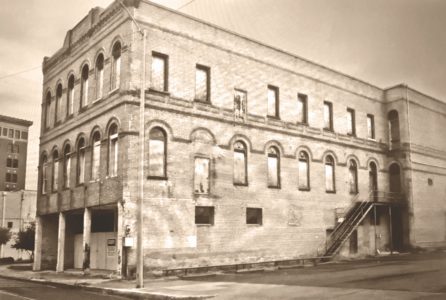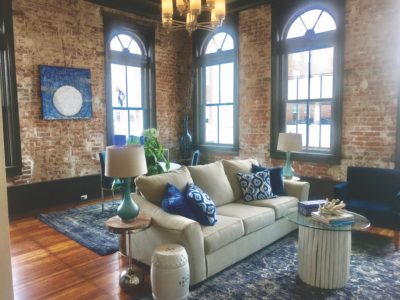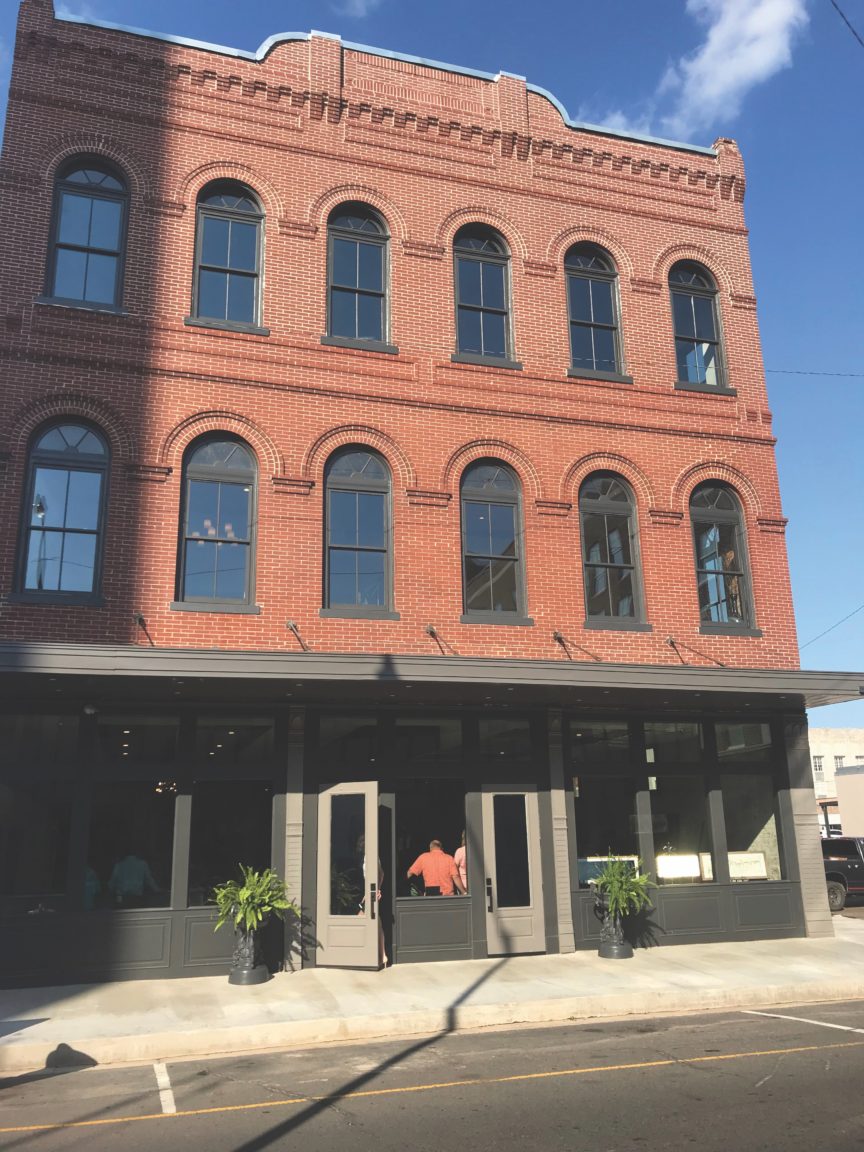“In order to restore a historic gem, you must go back to the beginning.”
The great building of Castle Hall is located at 125 St. John Street in downtown Monroe. Built in 1892, it was first used as Stonewall Lodge No. 8 of the Knights of Phythias. The concept and functionality of Castle Hall was devised by Thomas Owen Benton, the father of the late educator, Lida Benton, for which the now razed Lida Benton Elementary was named in South Monroe.
The Knights of Phythias was established in Washington D.C. as an Act of Congress in 1864. The Knights’ purpose was to ease the ills of the Civil War including assisting the widows and orphans of soldiers killed in this war.
 The original No. 8 Lodge was located at the corner of DeSiard and South Grand where Bry Park now sits. It was opened in 1864. The original charter members consisted of 12 Jews and 12 Christians. After a fire destroyed the building, plans were drawn up for what would become the Castle Hall building.
The original No. 8 Lodge was located at the corner of DeSiard and South Grand where Bry Park now sits. It was opened in 1864. The original charter members consisted of 12 Jews and 12 Christians. After a fire destroyed the building, plans were drawn up for what would become the Castle Hall building.
Among those 24 charter members was my great great grandfather, the Honorable Judge Robert Henry Endom, who happened to be the first judge for the city of Monroe, previously named Ft. Miro, after the reconfiguration after the Civil War. He was also on the building committee and donated 48 of the chairs that remained in the lodge during its existence.
The Knights of Phythias was a secret society and the lodge a gathering place for gentlemen. Its second floor was a private men’s club for socializing and recreation. It was a refuge for businessmen with a special by vote invitation and application process.
It was originally a two-story brick and mortar building with a wrap around balcony. In 1922, a third-floor annex was constructed as the lodge began to expand its membership. The first floor was a merchant space that housed New York Racket & Dry Goods. Later it was home to Standard Office and Sublett Bros. Mercantile. In its life, Castle Hall also hosted the Junior League of Monroe’s thrift shop, Bloomingdeals, Scalia’s Deli, and an events rental business.
In the 1940s, sisters Clarice and Golda Roan taught dance in the building until the 1970s. It was during this time that women began to use the building socially. Socials and dances were held with women only as guests.
In the 1950s, an African-American gentleman, George Murray, was hired to run the elevator and maintain the lodge. George had a daily presence at Castle Hall for more than 40 years. He was a fixture that lived through the segregation and integration of society.
In 1988, my father, Ron Downing, joined the Knights of Phythias. He was the only second-generation member of the lodge from a charter member in Castle Hall’s existence. A local historian and visionary, he saw the need for restoration and revitalization of the building. It became a family affair as my mother, Jan Downing, and my sister, Sarah Downing Watley, and I, spent much time there during the revitalization process. I played billiards on the second floor while my sister took to removing the sheets of plywood that had been placed over the gorgeous original floors. Historic colors were selected by my father and my mother led the reorganization of the kitchen areas on the social floor. Members pitched in to rejuvenate the lodge and make its two upper floors accessible to the public to rent for weddings, parties, and dances in a historic setting.
My father remained a member for more than a decade before leaving the lodge; at that time, membership was slowing dwindling. As the membership became rather small, the decision was made to sell the building to another historic preservation enthusiast, Melody Olson. It again became a building in disrepair as it sat shuttered, waiting for its next incarnation. The building began to show it age. After nearly a decade, Melody parted ways with Castle Hall.
 Real estate agent and investor, Jason Thomas, showed interest in this diamond in the rough. The front face was gone as were many of the windows and sashes. The floors had been mostly gutted and the ornate tin ceilings were caving in. Many would not see any potential or hope for Castle Hall. Having already placed some interest in downtown Monroe by moving into the Riverscape Condominiums in the former Penn Hotel on South Grand, Jason and his wife, Jennifer, knew how successful a renovation like this could be.
Real estate agent and investor, Jason Thomas, showed interest in this diamond in the rough. The front face was gone as were many of the windows and sashes. The floors had been mostly gutted and the ornate tin ceilings were caving in. Many would not see any potential or hope for Castle Hall. Having already placed some interest in downtown Monroe by moving into the Riverscape Condominiums in the former Penn Hotel on South Grand, Jason and his wife, Jennifer, knew how successful a renovation like this could be.
Michael and Christie Echols, developers, architect, Robert Ellis, and I, as designer and consultant, joined the Thomases to bring Castle Hall back to its former glory. Together, we formulated the process and plan to transform the building into downtown living spaces. The historical character of the building had to be preserved for integrity and historical significance. We also had to embrace and provide the luxuries and comforts of modern day living.
On June 15, 2017, we broke ground on Castle Hall Condos. I was thrilled to see that day come, as the third generation of my family with a tie to this 126-year old gem. It was a special day knowing that I was part of the process of restoring something my family helped construct and revitalize in the past.
All construction brings challenges, but the ghosts of the forefathers were not cooperating as redrafts and changes continued until Castle Hall’s completion. Bringing the final polish to the condos was my great friend, Richard Brown, and his team of painters and Johnathan Ryman and his team of carpenters worked hard to meet our official opening date on June 7, 2018.
 I also enlisted a team of talented merchants and designers; Jason’s daughter, Savanna Thomas, Shane Sullivan and Tyler Kimbell helped me create my vision for the spaces with furnishings and accessories. With Jennifer taking care of the marketing and Jason’s son, Tristan, on the electrical team of Copeland’s, it was another family working together on Castle Hall.
I also enlisted a team of talented merchants and designers; Jason’s daughter, Savanna Thomas, Shane Sullivan and Tyler Kimbell helped me create my vision for the spaces with furnishings and accessories. With Jennifer taking care of the marketing and Jason’s son, Tristan, on the electrical team of Copeland’s, it was another family working together on Castle Hall.
As opening night approached, we wanted the event to be a cultural experience as well has a restoration unveiling. Four extremely talented artists and friends, Courtney Payne Wetzel, Joni Dollar, Molly Engan and K’shana Hall Davis, were contacted to display their latest collections. In a building that began hosting only men, it was fitting to bring a feminine presence to highlight a new era in downtown Monroe. Bringing in a bit of the hip artist movement were the talents of artist and friend, Dustin Greer, with his street inspired works.
We found the right entertainment and musicians to add ambiance to the night and recall the buildings history. As guests arrived, Madison Hopkins entertained the crowd with her twirling fans of fire and majestic hued fabrics and hula hoops. It added a special vaudevillian moment of street performance. Brian Sivils and Kirby Rambin entertained the guests touring the building.
Throughout the tour, guests enjoyed some leisurely jazz from Austin George as they settled into the masterpiece of the third floor’s penthouse suite where the lodge hall meetings took place. The stage that once commanded the meetings was now his stage for the evening.
Local celebrity mixologist, Henry Manning, provided the libations and culinary artist, Chef Pat Nolan, tempted guests taste buds with some of the delicious dishes they can expect in the first floor retail space that will become Nolan’s Brick Oven Bistro, opening this summer.
 The former Castle Hall Lodge has been transformed into Castle Hall Condos. The building houses nine luxury, furnished condos that are now available for corporate lease and on AirBnB. Families and businessmen and women from around the USA have embraced it as a new place to live and stay while in Monroe. Residents and guests of Castle Hall Condos experience history with its unique Spanish-influenced architecture paired with modern-day conveniences. It is one of the oldest remaining buildings in downtown Monroe. It has been a true labor of love being a part of something that has been important to my family for so many decades.
The former Castle Hall Lodge has been transformed into Castle Hall Condos. The building houses nine luxury, furnished condos that are now available for corporate lease and on AirBnB. Families and businessmen and women from around the USA have embraced it as a new place to live and stay while in Monroe. Residents and guests of Castle Hall Condos experience history with its unique Spanish-influenced architecture paired with modern-day conveniences. It is one of the oldest remaining buildings in downtown Monroe. It has been a true labor of love being a part of something that has been important to my family for so many decades.
If you are traveling or looking for a staycation, I recommend Castle Hall Condos as your home away from home. The character of the building tells its own story. Now, if only these walls could talk.

